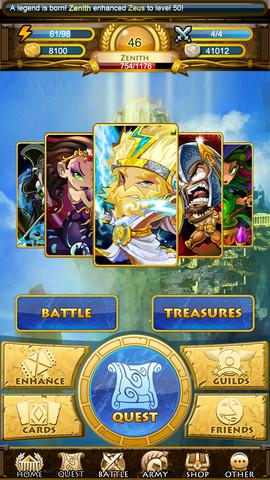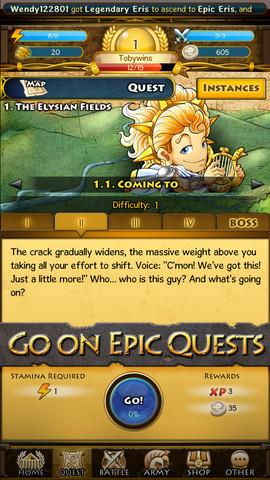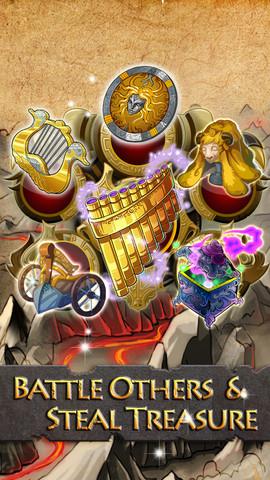- Wondering how to get Monopoly GO! free rolls? Well, you’ve come to the right place. In this guide, we provide you with a bunch of tips and tricks to get some free rolls for the hit new mobile game. We’ll …
Best Roblox Horror Games to Play Right Now – Updated Weekly
By Adele Wilson
Our Best Roblox Horror Games guide features the scariest and most creative experiences to play right now on the platform!The BEST Roblox Games of The Week – Games You Need To Play!
By Sho Roberts
Our feature shares our pick for the Best Roblox Games of the week! With our feature, we guarantee you'll find something new to play!All Grades in Type Soul – Each Race Explained
By Adele Wilson
Our All Grades in Type Soul guide lists every grade in the game for all races, including how to increase your grade quickly!
Pantheon the Legends Review
Anyone familiar with the collectible card battle game genre will feel right at home with Pantheon the Legends. You’ll complete “quests” to collect virtual cards representing gods, heroes, and other mythological figures from ancient Greece, enhance and ascend them, assemble treasures and, of course, battle your fellow players for fame, fortune, and bragging rights. In most ways it’s very much like other games in the CCG milieu, but it also adds a few new ideas to the mix and that makes it worth a second look.

The good kind of deja vu
Anyone familiar with the collectible card battle game genre will feel right at home with Pantheon the Legends. You’ll complete “quests” to collect virtual cards representing gods, heroes, and other mythological figures from ancient Greece, enhance and ascend them, assemble treasures and, of course, battle your fellow players for fame, fortune, and bragging rights. In most ways it’s very much like other games in the CCG milieu, but it also adds a few new ideas to the mix and that makes it worth a second look.
The first thing you’ll notice about Pantheon the Legends is its highly stylized take on creatures and characters ranging from mermaids and satyrs to the giant Argus Panoptes, Minos, Ariadne and even mighty Zeus himself, all of whom are rendered as bright, colorful caricatures that very quickly betray the game’s less-than-serious approach. Each card has a separate attack and defense rating, plus a ranking of one to five stars indicating its overall rarity and power, and can be made more powerful by enhancing and “ascending” them with other cards, which grants them new and unique powers. Finally, all the cards in the game belong to one of three factions, Order, Passion and Darkness, although thanks to the paper-thin tutorial and absence of any instructions or help option, what purpose these categories serve isn’t made clear.
Questing in Pantheon the Legends is a matter of simply spinning a virtual wheel, which will award some combination of silver, experience points and/or a new card with every spin. Each spin costs one or more stamina points, and once your stamina has run out, you’ll have to either refill it with a potion or wait for it to recharge on its own at a rate of one point per minute. Your total stamina grows by two points with every level gained but the demands of quests increase as you progress as well, and it won’t take long before you’re either waiting substantial amounts of time for your stamina to return or forking over money for restoration potions.
Once you achieve level 10 you’ll also gain access to “instanced” quests, which don’t use stamina but instead have a fixed, mandatory cool-down period between spins of the wheel. The enforced breaks, ranging from 30 seconds to two hours, make it a much slower process than conventional questing but the rewards are different and, generally speaking, better, and the instanced quests allow you to continue earning treasure, cards and experience while you wait for your stamina to return.
Multiplayer battles, the meat of any CCG, occur between “armies” of cards, although it’s a stretch to call them armies. You begin the game with just two slots for cards to use in players-versus-player ventures and can open up to two more by adding friends and attaching your Facebook account to your game account. The most obvious reason to square off against your fellow players is to steal one of their treasure pieces but you can also pick fights for fun and money, and the “rival” option lets you seek payback from those who have defeated you in previous encounters. But don’t expect to be throwing punches at everyone you see; PvP combat requires “spirit points” and their extremely slow recharge rate – two hours per point – ensures that most players will keep a lid on their multiplayer mayhem.


As is the norm with free-to-play games, you can access all that Pantheon the Legends has to offer without spending a penny, but your progress will be considerably slower than that of people who open their wallets once in awhile. There are plenty of things to throw your money at, including card packs that guarantee cards of a minimum rating, plus potions that recharge stamina or spirit, pouches of silver, trumpets, olive branches and more, and some aspects of the game will move at a glacial pace, or even be inaccessible, unless you pay.
It’s all very standard CCG stuff, but Pantheon the Legends does work in one or two interesting ideas of its own, with mixed results. The olive branch is a fun one: Instead of treasures being instantly and automatically assembled when all its pieces are collected, in this game it takes time to put them together, and in that time the pieces can still be stolen. Using an olive branch (or twig, which has a shorter duration) you put yourself under truce, meaning that nobody can attack you and steal your treasure while it’s being assembled. But it also means that you cannot attack anyone else; if you do, the truce is ended and you, and your treasure, immediately become vulnerable.
On the other side of the coin is a built-in global chat that allows you to talk to other people playing the game, which sounds like a very cool idea until you actually try it. You’re given five free messages in the chat room and once they’re used up you must buy “trumpets” if you want to speak again. Trumpets are relatively expensive – ten gold each, with gold being available for purchase through the in-game store in amounts starting at $4.99 for 400 – and each trumpet allows you one single line of text. Chatting, needless to say, is not something you’ll likely be doing very often.


The layout is clean and simple, with all major functions accessible through a small but not-unreasonably-cramped menu bar along the button of the screen, but the “X” button to close screens is annoyingly tiny and the game is often slow to respond to screen taps. A tutorial will take you through the basics but most of the game’s intricacies are left up to players to discover on their own, and although guilds are advertised, according to an in-game message they won’t actually be implemented until sometime in February.
Pantheon the Legends doesn’t have the built-in draw of licensed games like Transformers Legends or Marvel: War of Heroes, but I actually think I like the original setting a little better; the Greek mythos is an interesting backdrop in its own right and as a new game, it’s got plenty of room – and, yes, a definite need – to grow. It’s not likely to make converts out of non-fans but if you’re into the CCG scene, this one is definitely worth a look.

The good

The bad
More articles...
Monopoly GO! Free Rolls – Links For Free Dice
By Glen Fox
Wondering how to get Monopoly GO! free rolls? Well, you’ve come to the right place. In this guide, we provide you with a bunch of tips and tricks to get some free rolls for the hit new mobile game. We’ll …Best Roblox Horror Games to Play Right Now – Updated Weekly
By Adele Wilson
Our Best Roblox Horror Games guide features the scariest and most creative experiences to play right now on the platform!The BEST Roblox Games of The Week – Games You Need To Play!
By Sho Roberts
Our feature shares our pick for the Best Roblox Games of the week! With our feature, we guarantee you'll find something new to play!All Grades in Type Soul – Each Race Explained
By Adele Wilson
Our All Grades in Type Soul guide lists every grade in the game for all races, including how to increase your grade quickly!







